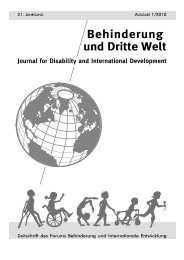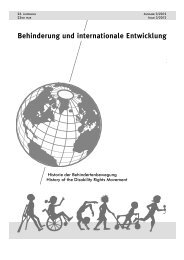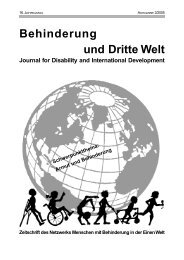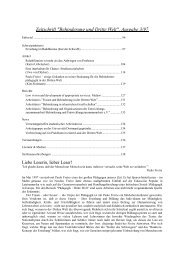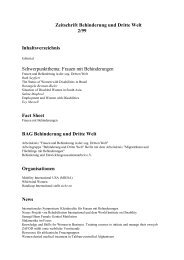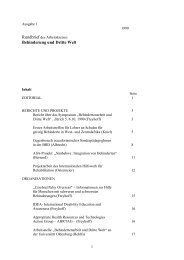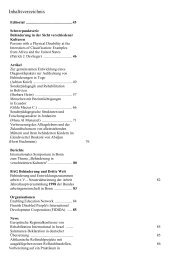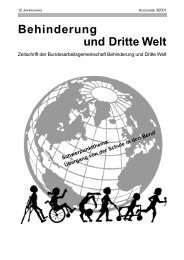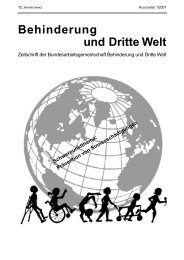Zeitschrift Behinderung und Dritte Welt
Zeitschrift Behinderung und Dritte Welt
Zeitschrift Behinderung und Dritte Welt
You also want an ePaper? Increase the reach of your titles
YUMPU automatically turns print PDFs into web optimized ePapers that Google loves.
S CHWERPUNKTTHEMAimplementation is critical to see policy comefully into practice.The National Commission on the Role of FilipinoWomen could potentially be a key player.However, despite its establishment over threedecades ago, communication barriers isolatedeaf and deaf Filipinas: First, from otherwomen with disability, and further, to the majorityof hearing Filipinas.Linkages with the academe, particularly withthe national University of the Philippines is verypromising. Awareness about the deaf at thecolleges of social work and community development,social sciences and philosophy (includinglinguistics and psychology) has been slowlygaining gro<strong>und</strong>. With about a dozen deaf studentsnow enrolled in the Diliman campus atthe college of education and college of finearts, initial steps have been taken by universityofficials to institutionalize accommodations fortheir needs (Bustos/Martinez 2008).Alliances with organizations such as VoluntaryService Overseas - Philippines, the Knowledgefor Development Centers of the WorldBank, and project support from The Asia Fo<strong>und</strong>ationand the US Agency for International Developmenthave brought wide and significantvisibility to the needs of the deaf in general,and deaf women in particular. Specific linkagesof the Phil. Federation of the Deaf to the WorldFederation of the Deaf network have also providedimportant support.ConclusionThe impact generated by advocacy efforts forand by deaf women in the Philippines is mostevident on the hearing majority of Filipinowomen. It has also strengthened internal tieswithin its own cultural minority. Influence on relationshipswith women with disability or evennon-signing deaf women has been limited.Deaf women have remained largely at theperiphery of both the women’s and disabilitymovements, and their concerns on sexualabuse and violence have not fully come to thesurface. In the same sense, the women’s anddisability sectors have also been at the peripheryof the deaf world, separated from them bycommunication barriers. Success in the futurehinges on an integration of deaf women intothe disability and women’s movements to overcomethese barriers in their multidimensionalcommunication relationships. Further researchand documentation on the problem of sexualabuse to deaf women is imperative. The greatervisibility of deaf women through comprehensiveand consistent sign language interpreting shallalso enable participatory membership into networksin both the women’s and disability sectors.Continued support to deaf women by individualsand entities who can communicate andinteract comfortably with both the deaf communityas well as the women’s and disabilitymovements is critical. This enabling support cansustain the linkages to academe, government,civil society and the public at large which havealready been initiated.Notes1 The FDWHCC is a deaf women’s advocacy organizationdocumenting and addressing issues on reproductivehealth, violence and human rights. It also providescounselling, survivor support and other forms ofsupport to Deaf women. It was established formally in2002 and is based in the Metro Manila area. It networkswith government entities (e.g. the Departmentof Social Welfare & Development), non-governmentalwomen’s organizations and shelters, and deaf womenthroughout the Luzon and Visayas areas.2 The PFD is a federation of over 20 Deaf organizationsall over the Philippines and is the official representativeto the World Federation of the Deaf, a globaldeaf advocate. Fo<strong>und</strong>ed in 1997, PFD has conductednationwide projects for the Status Report on the Useof Sign Language in the Philippines (National SignLanguage Committee) and the Online Corpus projectand was the Philippine counterpart for the PracticalDictionary for Asian-Pacific Sign Languages. It representsthe deaf community in cross disability endeavorsas well as policy planning with government agencies.Its overall goal is to empower the deaf to becomeunited, equal and productive members of society.3 The PDRC was fo<strong>und</strong>ed in 2001 on the cornerstonesof research, information and networking. It is guidedby the view of deafness as a culture in carrying out itsmission for research-based advocacy. It is the sole researchgroup for deaf issues and is active in publications,conferences and academic linkages. It is comprisedof hearing and deaf volunteers and maintainsstrong ties with grassroots deaf organizations to facilitatenetworking with government and non-governmentsectors.12 <strong>Zeitschrift</strong> <strong>Behinderung</strong> <strong>und</strong> <strong>Dritte</strong> <strong>Welt</strong> 3/2009



